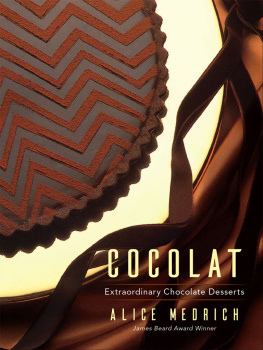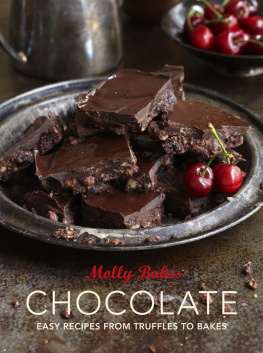SERIOUSLY BITTER SWEET
THE ULTIMATE DESSERT MAKERS GUIDE TO CHOCOLATE

ALICE MEDRICH
PHOTOGRAPHS BY DEBORAH JONES
PHOTOGRAPHIC STYLING BY SARA SLAVIN

ALSO BY ALICE MEDRICH
Cocolat: Extraordinary Chocolate Desserts
Chocolate and the Art of Low-Fat Desserts
Alice Medrichs Cookies and Brownies
A Year in Chocolate: Four Seasons of Unforgettable Desserts
Chocolate Holidays
Pure Dessert
Chewy Gooey Crispy Crunchy Melt-in-Your-Mouth Cookies
Sinfully Easy Delicious Desserts
Copyright 2003, 2013 by Alice Medrich
Photographs copyright 2003, 2013 by Deborah Jones
Giulianos Sweet and Spicy Meat Sauce with Chocolate, from Classic Techniques of Italian Cooking (1982) by Giuliano Bugialli, appears with the permission of its author. Recipes on pages published with the permission of Scharffen Berger.
Illustrations on by Donnie Cameron, from Cocolat by Alice Medrich, copyright 1990 by Alice Medrich. Reproduced by permission of the author.
All rights reserved. No portion of this book may be reproducedmechanically, electronically, or by any other means, including photocopyingwithout written permission of the publisher.
Published by Artisan
A division of Workman Publishing, Inc.
225 Varick Street
New York, NY 10014-4381
artisanbooks.com
Published simultaneously in Canada by Thomas Allen & Son, Limited
Library of Congress Control Number: 2013934750
eISBN 978-1-5796-5585-3
Photographic styling by Sara Slavin
Selected food styling by Sandra Cook
Cover design by Michelle Ishay-Cohen
Front cover and author photographs by Deborah Jones
To Lucy
Contents
Introduction

When Bittersweet was published in 2003, chocolate in America was on the brink of a seismic shift that would forever change our understanding of and our experience with this beloved food.
New and more interesting chocolatespurer, more flavorful, less sweet, different, even exotichad started to appear next to the familiar brands, and we were ready to, actually starting to, taste chocolate in a new way. But no one was explaining the difference between these chocolates and standard American chocolates, or providing guidance to cooks who would naturally want to make their favorite recipes successfully with the new chocolates.
In the decade since then, all of the changes presaged in the first edition have in fact occurred and have even sparked a new wave of chocolate innovation. This revised and updated paperback edition is (blessedly) simpler to use and understand, in part because terminology that had been new and unfamiliar is now common (it doesnt need repeated explanation anymore) and most especially because these days bars of chocolate are almost universally labeled with percentages. This latter fact makes it easier to call for a specific chocolate in a recipe, easier to shop for the right ingredient, and easier to make a successful chocolate dessert with any chocolate you choose using the guidelines in the book. Meanwhile, because there are hundreds more foreign and domestic chocolates available than there were ten years ago, chocolate-loving home cooks and culinary school students will find this book even more useful and relevant.
In addition to being a primer on chocolate, Seriously Bitter Sweet is a collection of great recipes, sweet and savory, each with choices or commentary on the chocolate called for. And my story is woven throughout: growing up with chocolate in California in the 1950s; tasting my first handmade chocolate truffle in Paris in 1973; the role of my Berkeley shop, Cocolat, in the context of the larger food revolution of the 1970s and 80s; and, finally, the years leading to the era of what I call the New Chocolates, which were the primary motivation for the book.
In retrospect, my first hint that American cookseven seasoned American cooks and pastry chefsmight need continuing education in chocolate came early. After I sold Cocolat in 1990, I had more time to write and publish cookbooks and experiment with new ingredients, including chocolates. When I started making desserts with a renowned European chocolate, one that I had tasted and loved but never worked with, I assumed that it would make my already superb desserts even better. I did not anticipate that a superior chocolate with 70% cacaoinstead of the then standard American bittersweet with 54% to 59% cacaowould produce an inferior dessert, simply because of its higher cacao percentage.
By 1997 I was spending time with the late Robert Steinberg and John Scharffenberger as they launched their tiny company, Scharffen Berger Chocolate Maker. In short order, Scharffen Berger became the first new American bean-to-bar chocolate manufacturer in fifty years; the first to make an American 70% bittersweet chocolate; and the first American company to put cacao percentage on a chocolate bar, to market cocoa nibs, and to produce a premium-quality natural American cocoa powder for home cooks. I was a casual consultant at first, then a friend and regular advisoroften, in truth, a nag. I dont take credit for what they did, but I did know very early on (even before John and Robert knew) that Scharffen Berger would change chocolate in the United States forever. And that is exactly what happened. At the same time, my experience with the new American chocolate provided the true impetus for Bittersweet.
At first to help John and Robert, and then to satisfy my growing curiosity, I started adapting some of my recipes to make them work with a 70% chocolate, then a 62% chocolate, and then several in between. Soon I had a set of formulas, observations, and rules of thumb. Meanwhile, a colleague said it was not worth paying for special chocolate if you were just going to cook with it. But I was finding that although good chocolate made good desserts, better chocolate yielded even better dessertsas long as you knew how to use it. I was also discovering that the simplest recipes were best for showing off distinctive chocolates.
The relatively quick success of the new chocolate upstart had an impact. American manufacturers started to include the cacao percentage on their labels (as I knew they would); they also began making higher-percentage chocolates. The family-owned Guittard Chocolate Company in California responded by launching their own excellent artisan chocolate line, E. Guittard, for professionals and home cooks. Furthermore, more chocolates from Europe and Latin America were showing up. Suddenly choices were multiplying in the baking aisle (and, of course, in the candy aisle). Bittersweet chocolatesnow with a spread from 54% to over 70% cacaowere no longer interchangeable with one another in a recipe.
Nor was the focus just on recipes for flourless chocolate cakes and chocolate mousse or even on new desserts. As the new century dawned, the focus was equally on the chocolate itself: the transformation of cocoa beans into chocolate, the source and quality of the beans, and the blending (or not blending) of them. There was talk of rare varietals and the possible existence of a fourth species, of fermentation and drying methods on cacao farms, and of chocolate production methods and choices. Now the focus was on the flavors inherent in the beans, new and diverse ideas about what chocolate really tasted like and how much sugar it should or should not have in it. Now there was even a chocolate flavor wheel modeled after the classic wine flavor wheel, custom-designed for discerning the flavors of chocolate. Chocolate had gained a new statustranscending candyand a growing respect for the complexity of its flavor and the skill required to transform beans to bars.







